Marketers who depend on ecommerce for revenue have to do more than ever with limited budgets.
The best place to start increasing efficiency is improving customer experience with Shopping Ads.
Ecommerce companies can reduce Shopping Ad budgets by 48% while generating the same amount of revenue.
Research has indicated this in the past, and several cases from Longtail UX users below demonstrate this in practice.
Nearly Half of All Shopping Ad Spend Is Wasted
In online retail, a full 76% of paid search goes to Shopping Ads. However, studies have shown that nearly half that spend is wasted. One simple change may be all it takes to eliminate that waste: listing multiple products on the landing page that match the shopper’s search (rather than just one single product.)
Considering that 18% of all ecommerce ad spend goes to paid search, reducing that waste can lead to significant savings – around 6.8% of the total ad budget – for companies looking to tighten their belts.
Why So Much Shopping Ad Spend Goes to Waste
Most shopping experiences that start with a click on a Shopping Ad need improvement, and the landing page is the issue. Typically, Shopping Ad landing pages feature only one product.
Take this example from Wayfair. Searching for a “black duvet cover set” delivers a Shopping Ad that leads to a single matching product:
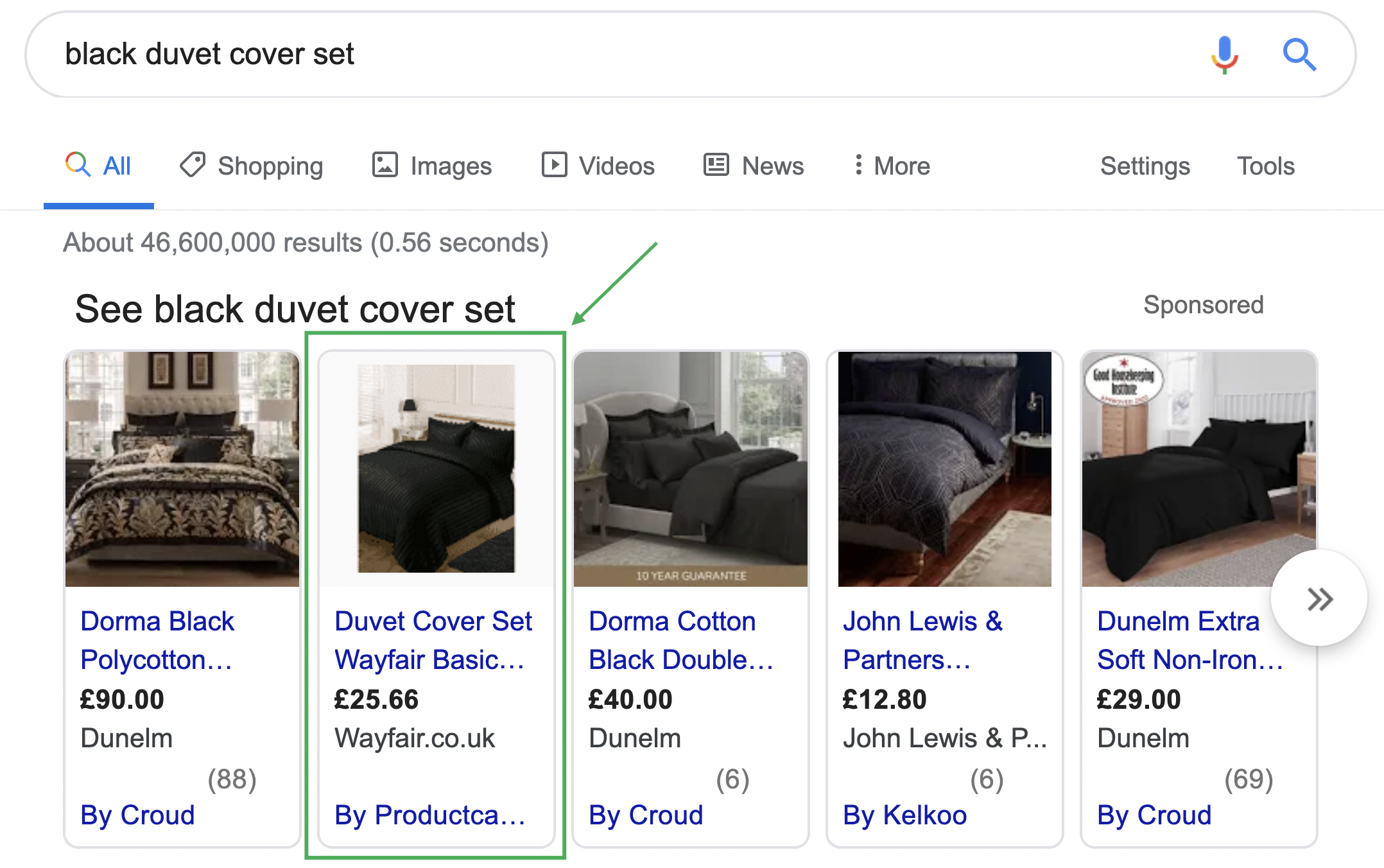
Arriving at the landing page, this one black duvet cover set takes up the entire page above the fold:
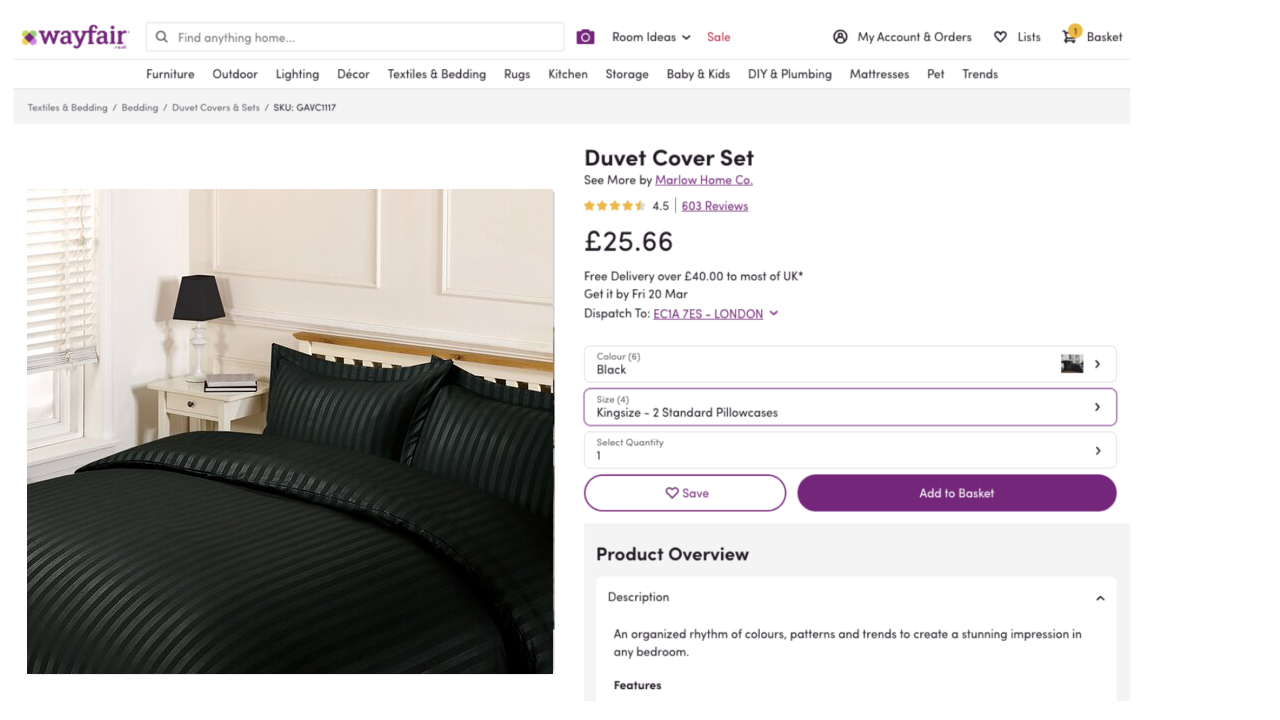
Nearly one in four online shopper journeys start on a “single product landing page” like this one. However, these pages do a relatively poor job converting buyers at the top of the funnel.
Customers in this “consideration phase” of the buyer’s journey are not ready to narrow their decision down to a single product.
They are seeking options, similar to customers browsing in a physical store. When one option is presented, only 1.5% of customers will convert to a sale.
“In online retail, a full 76% of paid search goes to Shopping Ads. However, studies have shown that nearly half that spend is wasted. One simple change may be all it takes to eliminate that waste: listing multiple products on the landing page that match the shopper’s search (rather than just one single product.)”
Multi-Product Landing Pages Can Double Conversion
Compare this to 2.9% – the rate a customer will buy when the landing page offers multiple products matching their search.
These pages feel more personalized to the shopper’s desires, and personalization has become an expectation for online consumers.

Here, the customer gets five options for products matching their search. This provides a sense of personalization on their first visit – a critical step to winning a loyal repeat customer.
A full 44% of shoppers said they are “likely” to buy from an online store repeatedly if it offers a personalized shopping experience, and 40% said they had purchased something more expensive than they originally planned when they encountered such an experience.
Conversely, 71% of shoppers expressed frustration towards shopping experiences that feel impersonal.
This frustration has led consumers in the US to move away from Google for product searches. While 35% of shoppers still start their search for products on Google, 47% now start on Amazon.
A quick comparison between the two search experiences illustrates why consumers prefer Amazon to Google Shopping.
The Amazon Shopping Search Experience Is Better for Consumers – But Harmful for Brands
Searching for the “black duvet cover set” on Amazon demonstrates their superiority in product search:
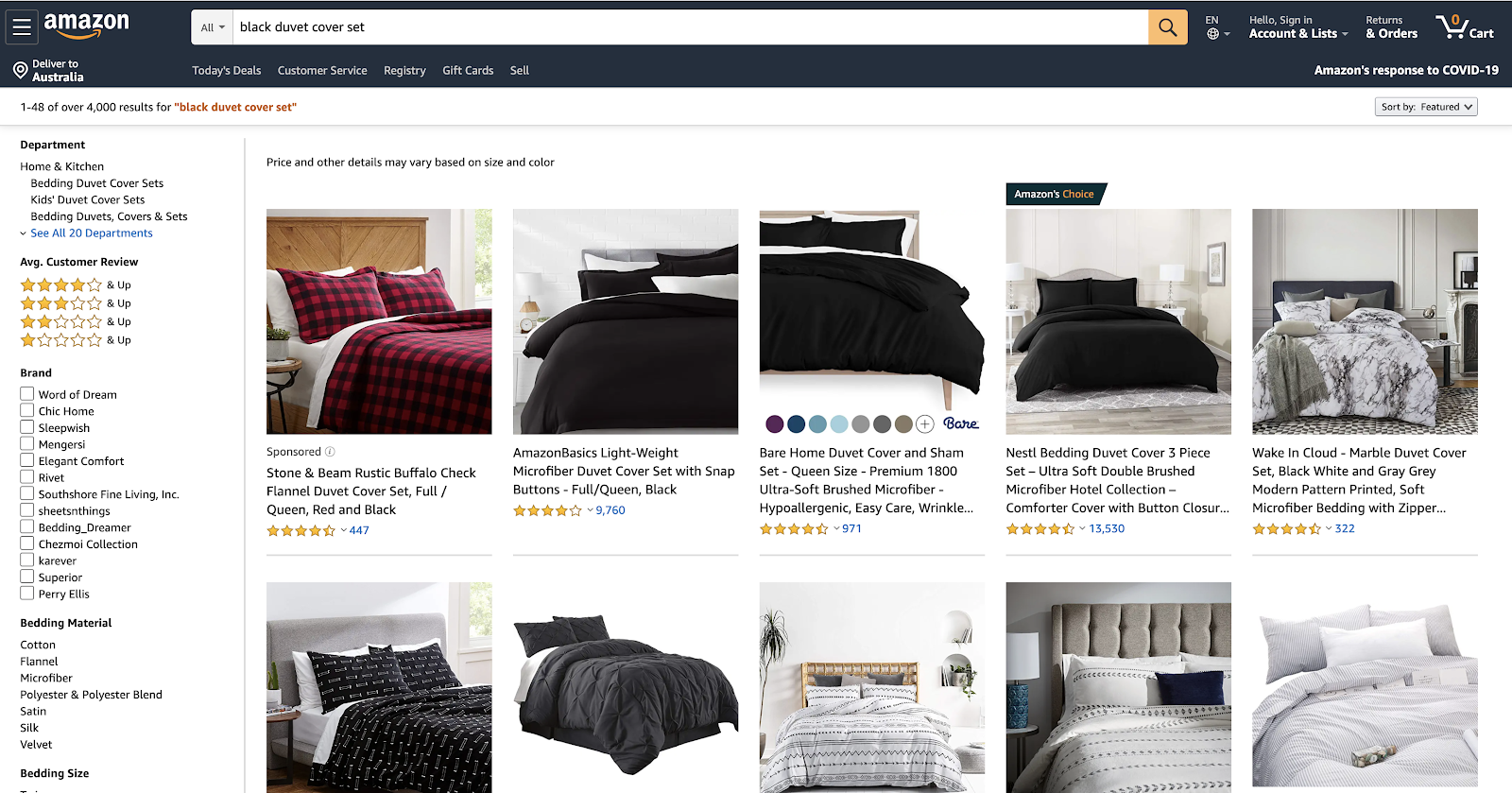
Amazon presents only multi-product landing pages for customers arriving from a search. Five of the eight products on this landing page match – which is great for the customer’s experience.
However, brands that depend on Amazon to provide this experience suffer in the long run. A consumer who buys your products on Amazon never visits your website, making it difficult to establish brand loyalty.
Unfortunately, selling on Amazon prevents ecommerce vendors from utilizing the most basic tools needed to maintain ROI:
- Retargeting
- List-building
- Upselling
- Cross-selling
Recreating the Amazon Shopping Experience With Google Shopping Ads
Google is extremely concerned about the threat from Amazon to their business, and wants to create the Amazon experience in the Google Shopping platform.
However, this is a challenge when the products they advertise span multiple ecommerce websites.
All you can do is open a new browser tab for each click. This causes the shopper to “pogo-stick” between the Shopping Ad results and the pages they open, closing a tab each time they choose not to buy the single product on the landing page.
The customer has to close that tab and click another Shopping Ad to see another product. This experience is agonizing for the shopper:

In the above example, the shopper has to click eight times across five tabs just to view four products. This experience explains why shoppers bounce from single product landing pages (72% higher than other landing page types.)
Ecommerce companies often go with these types of landing pages because of their ease of integration with Google Shopping Ads. But it is certainly not necessary to limit Shopping Ad landing pages to one matching product.
With a slight adjustment, ecommerce customers of Longtail UX get the best of all worlds:
- The superior, multi-product landing page experience of Amazon.
- Direct traffic to your website from Google Shopping Ads.
This combination delivers a superior user experience – saving shoppers time, and saving brands on ad spend.
Longtail UX customers are typically able to achieve 100% of their sales volume at 20-50% less paid search spend.
How It’s Done
Creating a parallel set of multi-product pages in addition to the single-product landing pages is achievable with in-house developer resources – but it’s costly and time-consuming.
In cases where the current ecommerce platform does not have the necessary capabilities, a full replatform might be required, which can take 12-18 months and cost hundreds of thousands of dollars, while risking interruption to your business when things go wrong.
Another option is to use a landing page generation tool like Longtail UX.
Longtail UX handles the most difficult parts of generating multi-product landing pages by:
- Aggregating multiple products onto one landing page per unique search query.
- Creating a multi-product template customized to the ecommerce website’s specifications.
- Hosting those pages on a lightning-fast CDN.
- Serving pages quickly via reverse proxy.
The more than 100 websites that have implemented Longtail UX to date have had impressive success.
AdoreBeauty: Ecommerce Case Study #1
AdoreBeauty, an ecommerce website with more than $100 million in annual turnover, used Longtail UX for its paid search Text Ads, netting a 169% increase in return on advertising spend (ROAS) on a 92% higher conversion rate.
Example search term: “invisible lip liner”
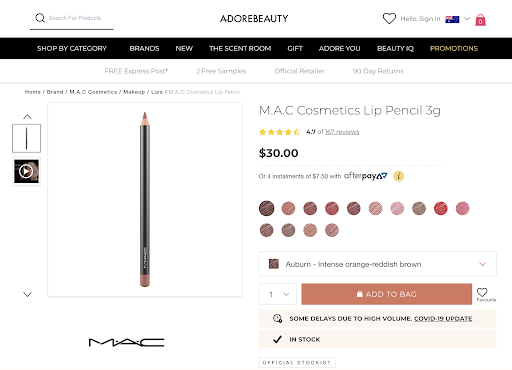
Before (Single product landing page)
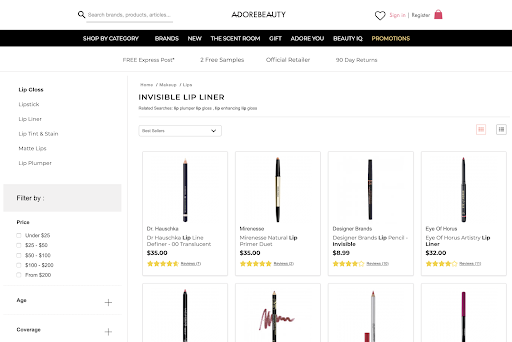
After (Multi-product landing page)
Vinomofo: Ecommerce Case Study #2
Vinomofo, an online wine deals site on pace for $60 million in revenue in 2020, used Longtail UX to optimise their paid search Text Ads.
Their more than 3,000 multi-product landing pages increase ROAS by 42%.
New customers acquired from Longtail UX pages placed 62% more orders with Vinomofo than customers acquired from other paid search campaigns.
Example search term: “sweet wine champagne”
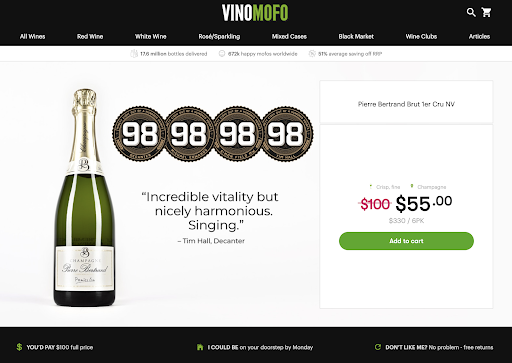
Before (Single product landing page)

After (Multi-product landing page)
Mobileciti: Ecommerce Case Study #3
Mobileciti, a bricks and clicks mobile phone store, used Longtail UX to optimise their paid search Text Ads.
By providing more matching options for phone brands on each landing page, Mobileciti was able to achieve a 95% increase in ROAS, with a 52% higher average order value.
Example search term: “samsung galaxy s10”

Before (Single product landing page)

After (Multi-product landing page)
Introducing Google Shopping On-Page Suggestions from Longtail UX
Due to the success of multi-product landing pages for paid search, we are rolling out the same service for Shopping Ads.
We are now open to inquiries from ecommerce companies looking to maintain sales volumes while reducing their Shopping Ad spend.
Customers who join the pilot program before June 1 will receive more benefits, including a guaranteed 15% increase in ROAS or your money back.
For inquiries on pricing and to find out what return on investment is possible for improving your shopping experience, set up a meeting with our optimization team here.
One Caveat: Multi-Product Landing Pages Only Work Better with Search
Multi-product landing pages are only recommended for shoppers arriving from the search channel. Other channels actually perform better with single product landing pages.
When email is the entrance channel, single product landing pages convert at a slightly higher rate. And shoppers from social media ads are nearly three times more likely to convert when they land on a single product landing page.

(Note: Up to 60% of “Direct” traffic is actually organic search traffic, which explains why conversion rates for “Direct” traffic are similar to search.)
The reason for this difference in search vs. social and email come down to the nature of user behavior and intention on those channels.
People browse email and social media. It is a passive process. They do not have a particular objective or item in mind. They have a mindset of making a potential unknown discovery, like a TV watcher randomly flipping through hundreds of channels.
Search is a different scenario. It is a mentally active process for the buyer. They want to find a particular item or piece of information, and intend to put in time to research which one will fill their personal need. This is why landing pages with multiple options for searchers to dive in and investigate convert so well.
Conclusion: Get More from Less Shopping Ad Spend
Ecommerce companies are tightening their belts right now, and with up to half of all Shopping Ad spend wasted, it’s the best place to start optimizing.
The main culprit with Shopping Ads seems to be the landing page. Having only one product offering on the page leads to shopper frustration, high bounce rates, and missed opportunities to sell.
Moreover, the customers who buy from websites offering multi-page landing pages seem to return more often and spend more money on each transaction.
To get involved with Longtail UX’s Shopping Ad pilot before June 1, schedule a session with our optimization team here.
You will find out how multi-product landing pages will work for your ecommerce offering and how much savings you can achieve.
Find out how much you can save in Shopping Ad budgets for your E-commerce website
The opinions expressed in this article are the sponsor's own.



